Weird white spots on rosemary are a widespread problem for many plant enthusiasts. So, what causes this mystery issue, and how to deal with it?
Let’s find out more about these white spots and get started with treatment!
White spots on rosemary plant: Reasons and remedies
White spots on rosemary can appear on both outdoor and indoor plants. However, the reasons can vary a lot, depending on the growing conditions and maintenance. What is more, you can’t treat your spotted rosemary properly until you know the exact cause. So, how to find it out?
Examine your rosemary leaves thoroughly. The character of white spots and their structure along with some extra signs will tell you about the exact reason. If you have a microscope lens, make use of it to see more details of the affected areas.

Powdery mildew
As for these white spots on rosemary, the best idea is to start with the most common culprit of this issue. Rosemary plants mostly suffer from powdery mildew invasion.
Powdery mildew is a common fungal disease that is provoked by a filamentous fungus. Brought by the wind, its spores can easily get onto the plant’s leaves and start growing there. In favorable conditions, fungal spores multiply extremely fast and affect not only the host plant but also the other plants in the crop.
Powdery mildew starts as tiny white spots on the leaves. Since the powdery mildew spores invade all the leaf surfaces, the plant looks like dusted with a thin layer of chalk powder (hence the name).
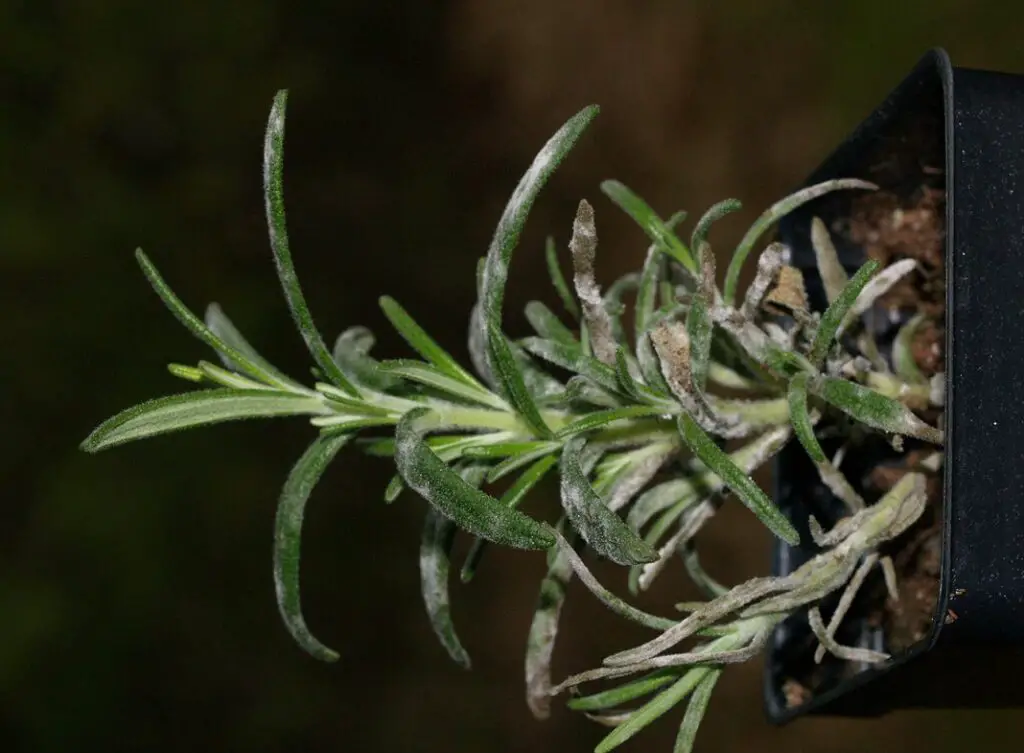
Although this type of fungi is not toxic, fungal growth can quickly cover all the leaf surfaces and prevent it from photosynthesis. It leads to stunted growth and fading of the rosemary plant. Finally, it can die if not treated at all.
How can you define powdery mildew? Take a closer look at the white spots on your rosemary plants. If they resemble a white powder scattered over the leaves, it is the powdery mildew. This white powdery coating is nothing but tiny fungal spores that are prone to invade all over the plant. If not stopped, powdery mildew will invade other plants nearby.
5 ways to treat powdery mildew
Fortunately, powdery mildew can’t kill the plant so quickly. When noticed and treated in time, you have all chances to revive affected plants.
First, remove the affected leaves from the plant. For this purpose, use a pair of disinfected scissors with sharp blades to provide a clean cut.
Treat scissors with rubbing alcohol regularly while pruning! This helps you to avoid spreading powdery mildew on rosemary while cutting the spotted leaves.

In case you grow potted rosemary plants on your window sill, isolate the infected plants to protect the healthy rosemary crop from powdery mildew pathogens. If you keep your rosemary plants in a humid place, take them to a dry and sunny place with enough air circulation.
Start treating as soon as you can! At the earlier stages, it is much easier to prevent powdery mildew from damaging the entire rosemary plant.
Opt for any of the 5 most popular remedies to treat powdery mildew:
- Organic fungicide
- Neem oil
- Baking soda solution
- Compost tea solution
- Milk solution
A great way to dispose of fungal infections on your rosemary leaves is to use special fungicide sprays designedfor treating powdery mildew. Pour the fungicide into a clean spray bottle and apply it on the rosemary leaves. Cover both tops and undersides of leaves to deal with all the affected areas.
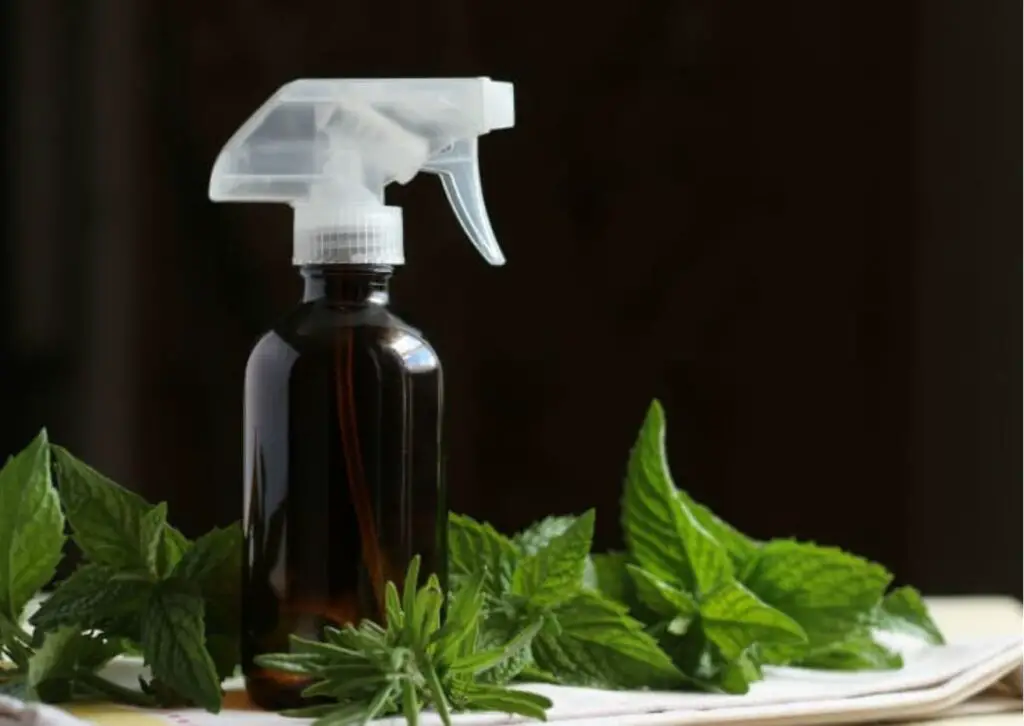
Neem oil is a versatile helper that works efficiently against many types of fungi and pests, including powdery mildew. Apply it evenly to the affected areas, and let it work for at least 24 hours. Then, rinse the plant thoroughly with a lot of settled or filtered warm water. Reapply the solution each 1-2 weeks until the fungus symptoms disappear.
Baking soda is a great natural remedy for a fungal attack on rosemary. Since baking soda changes the pH levels of rosemary leaves, the fungi disappear from the inhospitable alkaline surface.
Dissolve a tablespoon of baking soda in a cup of warm or lukewarm water. You can also add 3 tsp of horticultural oil or mild soap. Place the mixture into the spray bottle, and apply to the dry plant leaves. Repeat this procedure each week during the blooming season.
You can also get a commercial compost tea solution or just make it at home.
Mix some aged compost with water in a ratio of 1:5 and let it sit for about 1-2 weeks. Strain the mixture. Keep adding water again to make the mixture similar to brewed tea. Fill the spray bottle with the compost tea solution and spray your rosemary leaves. During the whole growing season, keep treating the infected plant once in 2 weeks.
Milk solution is one more alkaline treatment that can kill powdery mildew fungi. Mix some water and fat-free milk in a ratio of 1:1, place this mixture into the spray bottle, and spray evenly on the affected leaves.
How to prevent powdery mildew on rosemary?
For preventing powdery mildew on rosemary leaves, follow the tips below:
- Remember that humid weather always boosts fungal growth.
- Leave more space between the plants to provide enough air circulation and decrease the risk of getting infected by each other.
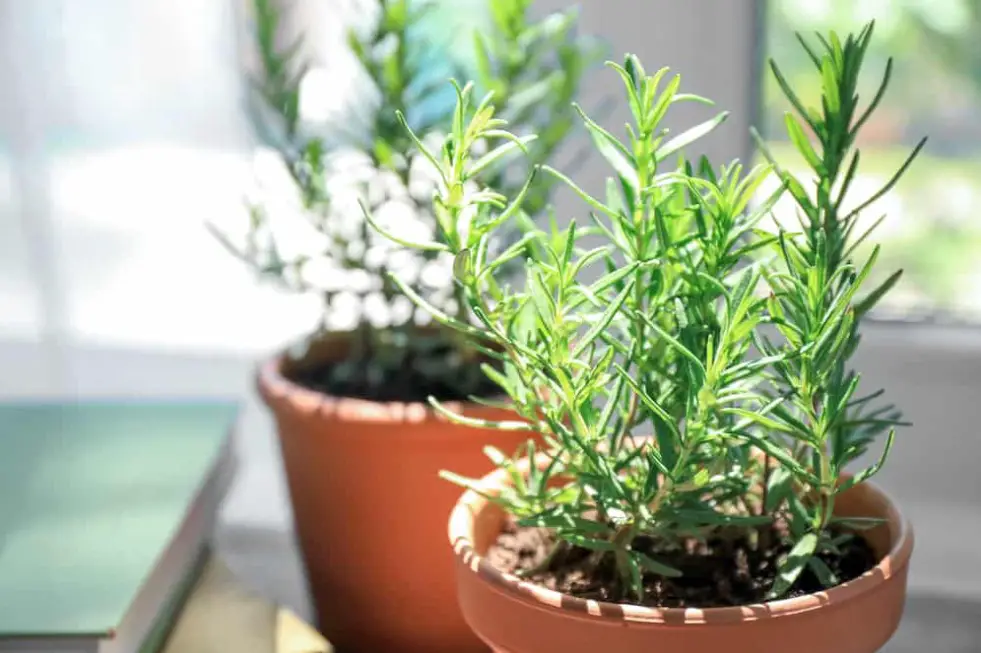
Cold water
Cold water is one more factor that leads to white spots on rosemary leaves. Along with too low temperature, cold water brings plenty of mineral deposits that settle on the rosemary leaves.
Tap water brings lots of mineral deposits onto the rosemary leaves. When often applied to the plants, they leave traces that can look like white spots on the leaves’ surfaces.
Spray the affected areas with a white vinegar solution. Make a mixture of 50/50 white vinegar and distilled water, and spray your plants to dispose of white spots caused by mineral deposits.
To avoid cold water damage, follow the tips below:
- Opt for filtered water instead of tap one. You can also settle tap water before watering sessions.
- Never use cold water just out of the tap! If you prefer to settle tap water instead of using filtered one, let it stay for a while until the contaminants sink to the bottom.
- Rosemary bushes prefer warm water. Forget about watering with those cold streams of tap water. The water should always be warm enough so as not to affect your rosemary crop!
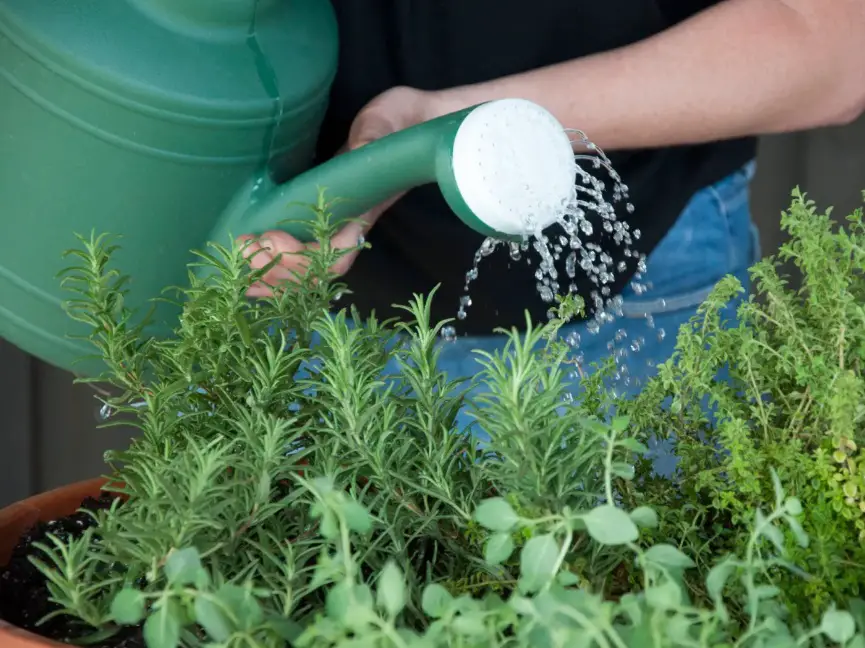
Pest infestation
Pests are mostly prone to appear outdoors, but if you grow rosemary inside, it is also vulnerable to pest infestation.
When appearing on plants, pests are one of the most common culprits of stunted growth and many external symptoms. Check your plants for any little bugs sitting on the surface or flying somewhere around.
Here is a list of the most common pests that you can find on rosemary leaves:
- Aphids
- Mealybugs
- Spider mites
- Whiteflies
You can easily notice signs of these pesky critters on your rosemary. Such pests as spider mites and white flies leave characteristic traces of their presence. As soon as you see them, start treating them immediately!
How to treat rosemary from a pest infestation?
First of all, remove all the visible pests, their eggs, webs, and other traces from the plant’s surfaces. Soak a cotton swab in rubbing alcohol, and make use of this tool to dispose of the pests and their traces.
Make use of the insecticidal soap to get rid of unwanted guests on your rosemary.
Neem oil remedy is also efficient against many pests, including spider mites.
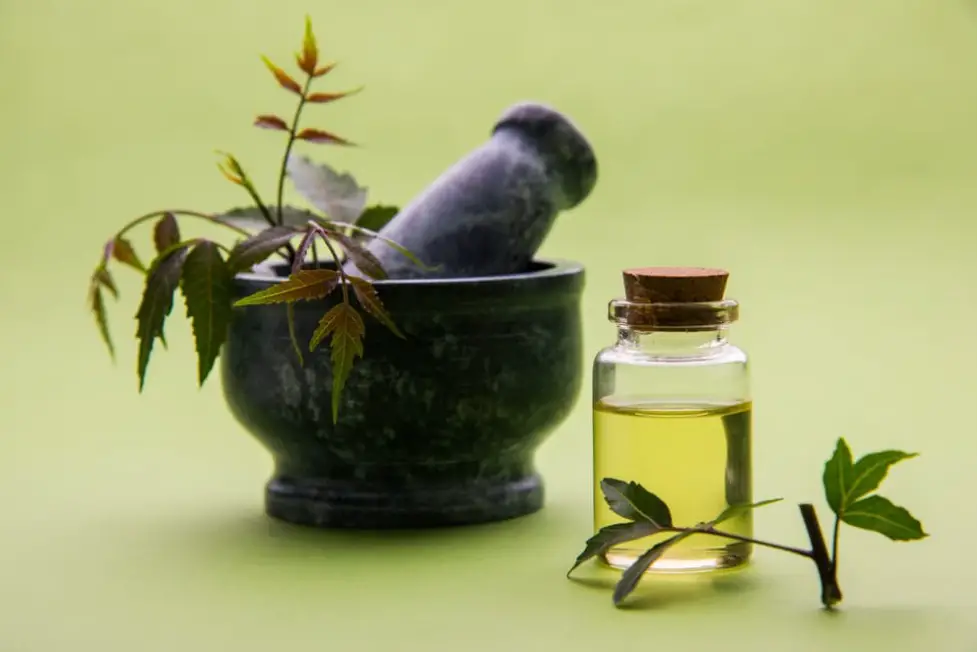
Lack of nutrients
Sometimes white spots appear on rosemary because of nutrient deficiency. Lack of nitrogen and some other nutrients can lead to white spots appearing on rosemary as well.
Feed your rosemary crop with nitrogen-rich or phosphorus-rich liquid fertilizers to replenish that lack of nutrients. As a variant, add some nutrient-rich compost to the growing medium.
Too much sun
Finally, the white spots on the leaves can be a result of sunburn. In case you notice that the leaves on your rosemary start bleaching and covering themselves with white spots, those are the earlier stages of sunburn.
Don’t let the leaves turn yellow or brown and fall off! Reduce sun exposure by removing your rosemary to another location if possible.
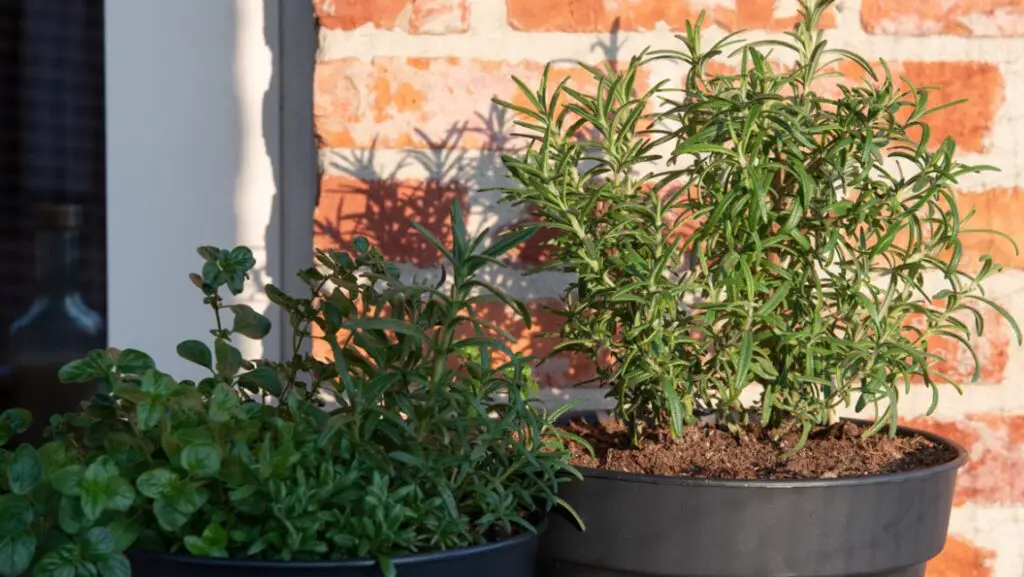
FAQ
Why does my rosemary have white spots on it?
Several reasons can cause white spots on rosemary:
– Powdery mildew
– Cold watering
– Pests
– Lack of nutrients
– Sunburn
Before you start treatment, find out the exact reason that affected your plants so that you can choose the right way to help them.
How do I get rid of white fungus on my rosemary plant?
There are many ways to defeat fungal infections. Here is a list of the most popular ones:
– Baking soda mixture
– Compost tea solution
– Fungicide remedy
– Neem oil spray
Can you eat rosemary with powdery mildew?
No, you can’t. Consuming fungal pathogens can cause allergic reactions. Generally, powdery mildew fungus is not dangerous for people, but in some cases, it can affect sensitive folks.
Avoid eating affected leaves of rosemary plants. However, there is nothing drastic if you accidentally consume a few leaves that have a spot or two.
What is the white, milky substance on my rosemary plant?
White milky honeydew, viscous and sticky, is most probably a trace of white flies living on rosemary. If these white traces look more like spiderwebs, they will tell you about spider mites on your rosemary bushes.
Treat your rosemary crop with insecticidal soap or neem oil to dispose of these pests.
Final thoughts
There may be different reasons that cause white spots on rosemary plants. Find out the exact culprit and start treating your crop just in time!
A garden is a place that relaxes us and reflects our personal style, it’s a place to spend time with loved ones and grow our own fruits and vegetables. Maybe you’re looking for design inspiration or plant selection, or you’re concerned about garden privacy, shady areas, or pests, but don’t worry, you’ve come to the right place.
